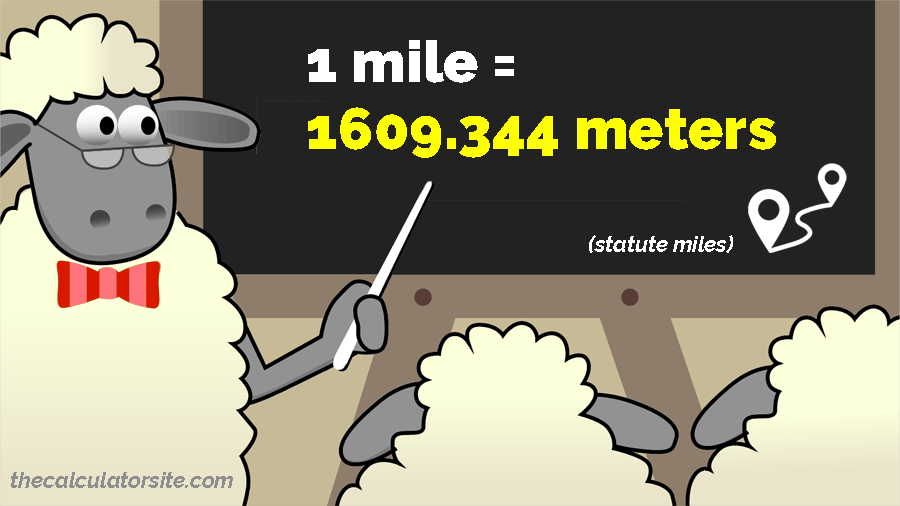How Many Meters Are in a Mile?
Miles and meters, meters and miles. If you happen to procure a time machine and meet a monocled Brit from 1825, they might give you directions to the nearest Olde Pie Shoppe in miles. And much obliged you would be for that, too. In fact, even if you talk to any Brit or American today - here in the 21st century - they'll probably still define distance using imperial units, whilst much of the rest of the world has moved on to the slightly tidier metric system.
So how is the modern Italian to interpret the Georgian English measurement? And how is the modern Brit or American to convert miles to meters when visiting Europe and making sense of meter-based satnavs, maps and road signs? Well, park up your time machine for just a moment so you can learn all about conversion of miles to meters.
Let's start with the bare facts.
One mile is the same as 1609.344 meters (or 'metres', if you're British). This means that 5 miles is 8046.72m and 10 miles is 16093.44m. To convert miles into meters, you simply multiply the number of miles by the number of meters in a mile: Number of miles × 1609.344m.

If you were hoping for some nice round figures to convert between, we can only apologise. Imperial and metric systems are totally different approaches to measuring, so it's a little like asking how many Hershey bars-long a Lamborghini is. Sure, you'll get the same result every time, but one was not designed with the other in mind, so it won't be a 'perfect' number. (The Lamborghini Gallardo is about 31.47 Hershey bars long, if you were wondering).
Converting miles to meters
The table below shows conversions for standard, statute miles to meters/metres.
| Miles | Meters | Miles | Meters |
|---|---|---|---|
| 1 | 1609.344 | 11 | 17702.784 |
| 2 | 3218.688 | 12 | 19312.128 |
| 3 | 4828.032 | 13 | 20921.472 |
| 4 | 6437.376 | 14 | 22530.816 |
| 5 | 8046.72 | 15 | 24140.16 |
| 6 | 9656.064 | 16 | 25749.504 |
| 7 | 11265.408 | 17 | 27358.848 |
| 8 | 12874.752 | 18 | 28968.192 |
| 9 | 14484.096 | 19 | 30577.536 |
| 10 | 16093.44 | 20 | 32186.88 |
Miles to meters calculator
As we like to be extra helpful, here's a calculator for converting other mile and meter figures.
"The mile is defined via the meter..."
Now, if you're looking for an answer to stun everyone into silence at your next neighborhood potluck (even more impressive than measuring in Hershey bars), you could get down to atomic level analysis of miles and meters and quote famous physicist Brian Cox, who recently tweeted that, "The mile is defined via the metre - defined as distance light travels in 1/299792458 of a second. A mile is 1609.344 metres. A second is 9,192,631,770 periods of the radiation corresponding to the two hyperfine levels of the ground state of the caesium-133 atom."
The mile is defined via the metre - defined as distance light travels in 1/299792458 of a second. A mile is 1609.344 metres. A second is 9,192,631,770 periods of the radiation corresponding to the two hyperfine levels of the ground state of the caesium-133 atom. @LaylaMoran
— Brian Cox (@ProfBrianCox) July 27, 2019
Got that? I'm sure we're all perfectly clear on his meaning so we won't bother elaborating further.
Oh, but when is a mile not a mile? When it's a Roman mile, of course! Learn the full, ridiculous history of the unit's name and definition in our 'How many feet in a mile?' article. And not to complicate things too much, but of course, you already know that a London mile is 1524m, an international nautical mile is 1852m, an Irish mile is 2048m and a Russian mile is 7468m. (Don't worry: most of those are obsolete now!).
Some mile units - past and present
- 1 international nautical mile = 1852 meters
- 1 UK nautical mile = 1853.184 metres (obsolete - ref)
- 1 London mile = 1524 metres (obsolete)
- 1 Irish mile = 2048 meters (used until the 19th century)
- 1 Russian mile = 7468 meters (used until 1925)
- 1 Chinese mile = 500 meters (ref)
For further reference, this Wikipedia article lists other variants of the mile used in the past.
